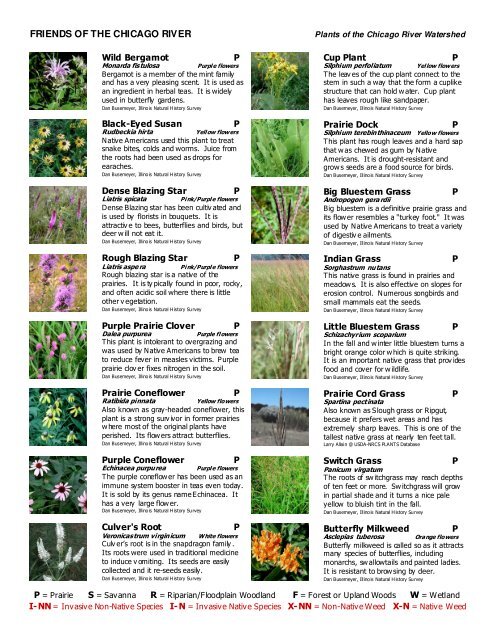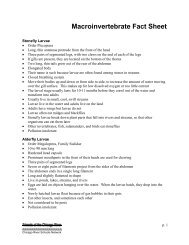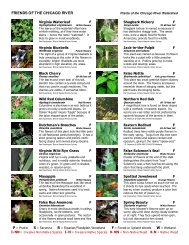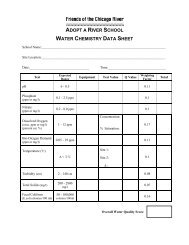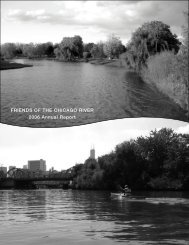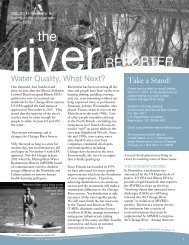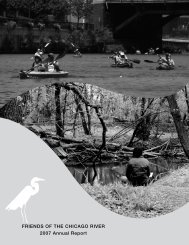Plants of the Chicago River Watershed - Friends of the Chicago River
Plants of the Chicago River Watershed - Friends of the Chicago River
Plants of the Chicago River Watershed - Friends of the Chicago River
You also want an ePaper? Increase the reach of your titles
YUMPU automatically turns print PDFs into web optimized ePapers that Google loves.
FRIENDS OF THE CHICAGO RIVER <strong>Plants</strong> <strong>of</strong> <strong>the</strong> <strong>Chicago</strong> <strong>River</strong> <strong>Watershed</strong><br />
Wild Bergamot P<br />
Monarda fistulosa Purpl e flowers<br />
Bergamot is a member <strong>of</strong> <strong>the</strong> mint family<br />
and has a very pleasing scent. It is used as<br />
an ingredient in herbal teas. It is widely<br />
used in butterfly gardens.<br />
Dan Busemeyer, Illinois Natural H istory Survey<br />
Black-Eyed Susan P<br />
Rudbeckia hirta Yell ow flowers<br />
Native Americans used this plant to treat<br />
snake bites, colds and worms. Juice from<br />
<strong>the</strong> roots had been used as drops for<br />
earaches.<br />
Dan Busemeyer, Illinois Natural H istory Survey<br />
Dense Blazing Star P<br />
Liatris spicata Pi nk/Purpl e flowers<br />
Dense Blazing star has been cultiv ated and<br />
is used by florists in bouquets. It is<br />
attractiv e to bees, butterflies and birds, but<br />
deer w ill not eat it.<br />
Dan Busemeyer, Illinois Natural H istory Survey<br />
Rough Blazing Star P<br />
Liatris aspe ra Pi nk/Purpl e flowers<br />
Rough blazing star is a native <strong>of</strong> <strong>the</strong><br />
prairies. It is ty pically found in poor, rocky,<br />
and <strong>of</strong>ten acidic soil where <strong>the</strong>re is little<br />
o<strong>the</strong>r v egetation.<br />
Dan Busemeyer, Illinois Natural H istory Survey<br />
Purple Prairie Clover P<br />
Dalea purpurea Purple fl owers<br />
This plant is intolerant to overgrazing and<br />
was used by Native Americans to brew tea<br />
to reduce fever in measles victims. Purple<br />
prairie clov er fixes nitrogen in <strong>the</strong> soil.<br />
Dan Busemeyer, Illinois Natural H istory Survey<br />
Prairie Coneflower P<br />
Ratibida pinnata Yellow flowers<br />
Also known as gray-headed coneflower, this<br />
plant is a strong surv ivor in former prairies<br />
w here most <strong>of</strong> <strong>the</strong> original plants have<br />
perished. Its flow ers attract butterflies.<br />
Dan Busemeyer, Illinois Natural H istory Survey<br />
Purple Coneflower P<br />
Echinacea purpurea Purpl e flowers<br />
The purple coneflow er has been used as an<br />
immune system booster in teas even today.<br />
It is sold by its genus name Echinacea. It<br />
has a very large flow er.<br />
Dan Busemeyer, Illinois Natural H istory Survey<br />
Culver's Root P<br />
Veronicastrum virginicum White flowers<br />
Culv er’s root is in <strong>the</strong> snapdragon family .<br />
Its roots were used in traditional medicine<br />
to induce v omiting. Its seeds are easily<br />
collected and it re-seeds easily.<br />
Dan Busemeyer, Illinois Natural H istory Survey<br />
Cup Plant P<br />
Silphium perfoliatum Yel low flowers<br />
The leav es <strong>of</strong> <strong>the</strong> cup plant connect to <strong>the</strong><br />
stem in such a way that <strong>the</strong> form a cuplike<br />
structure that can hold w ater. Cup plant<br />
has leaves rough like sandpaper.<br />
Dan Busemeyer, Illinois Natural H istory Survey<br />
Prairie Dock P<br />
Silphium terebinthinaceum Yellow flowers<br />
This plant has rough leaves and a hard sap<br />
that w as chewed as gum by Native<br />
Americans. It is drought-resistant and<br />
grow s seeds are a food source for birds.<br />
Dan Busemeyer, Illinois Natural H istory Survey<br />
Big Bluestem Grass P<br />
Andropogon gera rdii<br />
Big bluestem is a definitive prairie grass and<br />
its flow er resembles a "turkey foot." It was<br />
used by Native Americans to treat a variety<br />
<strong>of</strong> digestiv e ailments.<br />
Dan Busemeyer, Illinois Natural H istory Survey<br />
Indian Grass P<br />
Sorghastrum nutans<br />
This native grass is found in prairies and<br />
meadow s. It is also effective on slopes for<br />
erosion control. Numerous songbirds and<br />
small mammals eat <strong>the</strong> seeds.<br />
Dan Busemeyer, Illinois Natural H istory Survey<br />
Little Bluestem Grass P<br />
Schizachyrium scoparium<br />
In <strong>the</strong> fall and w inter little bluestem turns a<br />
bright orange color w hich is quite striking.<br />
It is an important native grass that prov ides<br />
food and cover for w ildlife.<br />
Dan Busemeyer, Illinois Natural H istory Survey<br />
Prairie Cord Grass P<br />
Spartina pectinata<br />
Also known as Slough grass or Ripgut,<br />
because it prefers wet areas and has<br />
extremely sharp leaves. This is one <strong>of</strong> <strong>the</strong><br />
tallest native grass at nearly ten feet tall.<br />
Larry Allain @ USDA-NRCS PLANTS Database<br />
Switch Grass P<br />
Panicum virgatum<br />
The roots <strong>of</strong> sw itchgrass may reach depths<br />
<strong>of</strong> ten feet or more. Sw itchgrass will grow<br />
in partial shade and it turns a nice pale<br />
yellow to bluish tint in <strong>the</strong> fall.<br />
Dan Busemeyer, Illinois Natural H istory Survey<br />
Butterfly Milkweed P<br />
Asclepias tuberosa Orange flowers<br />
Butterfly milkweed is called so as it attracts<br />
many species <strong>of</strong> butterflies, including<br />
monarchs, sw allowtails and painted ladies.<br />
It is resistant to brow sing by deer.<br />
Dan Busemeyer, Illinois Natural H istory Survey<br />
P = Prairie S = Savanna R = Riparian/Floodplain Woodland F = Forest or Upland Woods W = Wetland<br />
I-NN = Invasive Non-Native Species I-N = Invasive Native Species X-NN = Non-Native Weed X-N = Native Weed
FRIENDS OF THE CHICAGO RIVER <strong>Plants</strong> <strong>of</strong> <strong>the</strong> <strong>Chicago</strong> <strong>River</strong> <strong>Watershed</strong><br />
Common Mountain Mint P<br />
Pycnan<strong>the</strong>mum virginianum White flowers<br />
Mountain mint smells just like its name!<br />
Only bee-lov ers should consider this plant<br />
for <strong>the</strong>ir gardens. Mountain mint has leaves<br />
and flow ers that are faintly sweet.<br />
Dan Busemeyer, Illinois Natural H istory Survey<br />
Wild Quinine P<br />
Par<strong>the</strong>nium integrifolium White flowers<br />
There was a brief demand to harvest w ild<br />
quinine as a medicine to combat malaria<br />
during World War I. It prefers sandy to<br />
loamy soils that are w ell-drained.<br />
Dan Busemeyer, Illinois Natural H istory Survey<br />
Rattlesnake Master P<br />
Eryngium yuccifolium White flowers<br />
This plant was named so because it was<br />
thought that it could cure rattlesnake bites,<br />
w hich is not true. It is unusual in that it has<br />
parallel-v eined leaves.<br />
Dan Busemeyer, Illinois Natural H istory Survey<br />
Rosinweed P<br />
Silphium integrifolium Yellow fl owers<br />
Rosinw eed has broad, lance-shaped leaves<br />
that hav e small stiff hairs on top & bottom.<br />
It produces a fragrant resin that was<br />
chewed as a gum by Native Americans<br />
Dan Busemeyer, Illinois Natural H istory Survey<br />
Shooting Star P<br />
Dodeca<strong>the</strong>on meadii Pink/ purple flowers<br />
This plant prefers meadow s and prairies <strong>of</strong><br />
<strong>the</strong> eastern tallgrass prairie. It has hollow,<br />
leafless stalk div ided at <strong>the</strong> top into slender<br />
branches, each w ith one flower.<br />
Dan Busemeyer, Illinois Natural H istory Survey<br />
Compass Plant P<br />
Silphium laciniatum Yellow flowers<br />
This plant is named so because <strong>the</strong> leav es<br />
supposedly turn toward <strong>the</strong> north. It has<br />
very rough leaves and a hard sap that w as<br />
chewed as gum by Native Americans.<br />
Dan Busemeyer, Illinois Natural H istory Survey<br />
Sneezeweed P<br />
Helenium autumnale Yell ow flowers<br />
This plant, also know n as Helen’s flower, is<br />
mildly poisonous to liv estock. Settlers used<br />
<strong>the</strong> dried flow ers as snuff. It is v ery<br />
attractiv e to bees, moths and butterflies.<br />
Dan Busemeyer, Illinois Natural H istory Survey<br />
Sawtooth Sunflower P<br />
Helianthus grosseserratus Yellow flowers<br />
The seeds <strong>of</strong> <strong>the</strong> saw tooth w ere eaten<br />
baked or ground for use in flour and as a<br />
source for oil. Pheasants, goldfinches,<br />
dov es, and deer use it for food.<br />
Dan Busemeyer, Illinois Natural H istory Survey<br />
Whorled Milkweed P<br />
Asclepias verticillata White flowers<br />
A mildly -poisonous plant, whorled milkw eed<br />
sap w as used experimentally to provide a<br />
rubber substitute during WWII. It’s<br />
commonly found throughout dry prairies.<br />
Dan Busemeyer, Illinois Natural H istory Survey<br />
Common Milkweed P/W<br />
Asclepias syriaca Pi nk flowers<br />
This milkw eed has thick pods w ith cottony<br />
seeds inside that were once used to fill life<br />
jackets on boats. Native Americans made<br />
sugar by boiling <strong>the</strong> flow ers.<br />
Dan Busemeyer, Illinois Natural H istory Survey<br />
Cardinal Flower P/W<br />
Lobelia cardina lis Red fl owers<br />
Hummingbirds and butterflies are strongly<br />
attracted to <strong>the</strong> cardinal flow er. Beautiful<br />
but deadly, this plant is poisonous. It<br />
contains alkaloids like those in nicotine.<br />
Dan Busemeyer, Illinois Natural H istory Survey<br />
Golden Alexanders P/R<br />
Zizia aurea Yellow flowers<br />
In <strong>the</strong> w ild, this plant grows in rich, moist<br />
w oods, open meadow s and on riv erbanks.<br />
Early settlers thought this plant w as a cure<br />
for sy philis.<br />
Dan Busemeyer, Illinois Natural H istory Survey<br />
Queen Anne's Lace X-NN<br />
Daucus caro ta White flowers<br />
Queen Anne's lace is actually a type <strong>of</strong><br />
carrot. It is primarily found on roadsides<br />
and abandoned fields. It is nativ e to Asia<br />
and a weed in Europe and here in America.<br />
Dan Busemeyer, Illinois Natural H istory Survey<br />
Cutleaf Teasel I-NN<br />
Dipsacus laciniatus Pale pur ple flowers<br />
Teasel inv ades prairies and woodlands. It is<br />
an extremely aggressive and very hard to<br />
control as it can come back even if <strong>the</strong>re is<br />
only a little <strong>of</strong> <strong>the</strong> root left.<br />
Dan Busemeyer, Illinois Natural H istory Survey<br />
Bull Thistle I-NN<br />
Cirsium vulgare Pink/purple flowers<br />
The large spikes on this plant make it<br />
unpleasant and unpalatable to many<br />
animals. It invades prairies and woodlands<br />
w ith its spiny leav es and annoying stems.<br />
Dan Busemeyer, Illinois Natural H istory Survey<br />
Red Clover I-NN<br />
Trifolium pretense Pink/red flowers<br />
Red clover, a member <strong>of</strong> <strong>the</strong> pea family, is<br />
found on roadsides and old fields but can<br />
invade prairies. It w as introduced from<br />
Europe as a hay and pasture crop.<br />
Rusty Russell @ USDA-NRCS PLANTS Database<br />
P = Prairie S = Savanna R = Riparian/Floodplain Woodland F = Forest or Upland Woods W = Wetland<br />
I-NN = Invasive Non-Native Species I-N = Invasive Native Species X-NN = Non-Native Weed X-N = Native Weed


